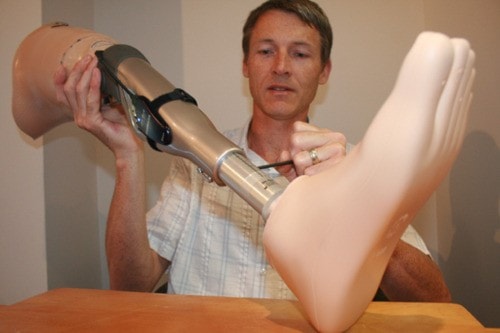Douglas Blake is looking forward to taking a stroll with his wife, Joan, thanks to a new bionic leg that’s giving him more freedom and mobility.
The Ladysmith couple has been married for 56 years and Blake says it’s the simple things he is looking forward to. Even just a trip to the grocery store or the shopping mall together is a daily activity he can’t wait to experience again.
The 79-year-old veteran had his left leg amputated 13 years ago after a blood clot formed behind his knee and gangrene set into his foot.
He had a prosthetic leg, but usually opted to use a wheelchair because it was easier to get around. Walking with his artificial metal leg, which has a locked knee joint, was a challenge.
Blake had to exert considerable energy just to pick the leg up – the foot would often get stuck to the ground. He had to use twice as much energy as someone without an amputation and because the prosthesis was also shorter than his other leg, he had an irregular walking pattern.
“You can’t really walk with the stiff leg,” said Blake, jokingly refering to it as a newer version of a pirate's peg leg.
Blake will soon have the freedom to walk where he chooses with a C-Leg Compact, manufactured by Otto Bock.
The prosthesis incorporates microprocessor technology, sometimes referred to as bionic technology.
The microprocessing computer learns and adapts to a person’s walking pattern and a series of sensors scan the terrain and gauges slopes and uneven surfaces for a safer walking experience. It will also enable Blake to walk with a nearly normal gait.
“The result is a much safer and more confident walking environment for the amputee,” said Nanaimo’s Markus Saufferer, a prosthetist with Motion Prosthetics. “The technology can really make a huge difference to someone's life and quality of life.”
Blake knew about the technology for years, but didn’t believe it was an attainable option until he was introduced to Saufferer after a hip replacement in May.
Saufferer said the technology has been available for about 15 years but is becoming easier to access because of increased competition among manufacturers. He said unfortunately there is a perception the technology is for the elite or rich or is in the experimental stages and unattainable.
The technology can be expensive, a C-Leg Compact, which is designed for less active individuals, can cost around $20,000 and a C-Leg can cost around $30,000.
But in the long run, it could save the health system money because amputees could avoid falls that require hospitalization and perhaps even surgery, said Saufferer. Falls can be more common with the straight leg because of its inflexibility.
The C-Leg technology isn’t covered by B.C. PharmaCare and Blake is getting help from the Royal Canadian Legion to cover some of the costs for the leg.
Blake tried the test unit for the past four weeks and was fitted with his new C-Leg Compact Friday.
He’ll undergo physiotherapy with Saufferer for the next four weeks to learn how to walk with the C-leg, because he’s used to overcompensating with his old prosthetic. Saufferer will also make adjustments to the leg to optimize Blake’s gait.
reporter3@nanaimobulletin.com
